Final report for GW21-226
Project Information
Livestock production contributes to >40% of the agricultural economy in New Mexico. High yield and quality of forage provide the foundation for the success of the livestock-based economy. However, low water and nutrient use efficiency challenges sustaining forage-based agriculture in the southwestern region. Farmers often over-apply N fertilizer to increase forage productivity because of the high demand for feed and forage. Forage crops require a large amount of nutrients, specifically nitrogen (N). However, high N application rates in irrigated forage production systems can lead to N loss through leaching and runoff, thus posing serious threats to the environment and human health. In this study, we integrated cover crops in forage corn and sorghum systems and tested the N use efficiency compared to the control.
Our results showed that cover crops could reduce 78–89% of inorganic N in the soil profile (0–80 cm) compared to the control. However, they can recycle the N back, with the potential of 20–38 kg N ha-1 from aboveground biomass, and increase subsequent forage crop yield by 18–23% compared to the control. This information is valuable to farmers for optimizing N fertilizer rates by synchronizing N release from cover crop residue decomposition, leading to increased cash crop yield while minimizing environmental risks such as N leaching. Promising results from cover crop-integrated forage systems can benefit farmers and potentially boost adoption rates in the region.
Research findings from this study were shared with local farmers through farmer’s field day, regional conferences, and seminars, with a total of 214 participants, including agricultural professionals, researchers, students, and farmers.
Research Objectives
- Estimate the soil inorganic N content using deep-profile water samples in a cover crop-integrated forage production system.
- Determine crop yield and N-use efficiency of forage crops.
Education/outreach Objectives
- Disseminate the project results to the local growers and the general audience (researchers, educators, students, and policymakers).
| Activities | 2021 | 2022 | 2023 | ||||||||||||||||||
| Aug | Sept | Oct | Nov | Dec | Jan | Feb | Mar | Apr | May | June | July | Aug | Sept | Oct | Nov | Dec | Jan | Feb | Mar | Apr | |
| Seasonal monitoring of crops | |||||||||||||||||||||
| Cover crops plantation | X | X | |||||||||||||||||||
| Cover crops termination | X | ||||||||||||||||||||
| Forage (corn & sorghum) plantation | X | ||||||||||||||||||||
| Forage (corn & sorghum) harvest | X | ||||||||||||||||||||
| Crop measure | |||||||||||||||||||||
| Cover crop biomass | X | ||||||||||||||||||||
| Cover crop quality | X | X | X | ||||||||||||||||||
| Forage biomass | X | ||||||||||||||||||||
| Forage quality | X | X | |||||||||||||||||||
| Soil | |||||||||||||||||||||
| Sampling | X | X | X | ||||||||||||||||||
| Monthly monitoring of soil inorganic nitrogen from water samples and soil profile moisture content | X | X | X | X | X | X | X | X | X | X | X | X | X | ||||||||
| Outreach activities | |||||||||||||||||||||
| Farmer's field day and visit | X | X | |||||||||||||||||||
| Project evaluation | X | X | X | X | X | X | |||||||||||||||
| Extension and journal article | X | X | X | X | |||||||||||||||||
| Social media coverage | On special project events | ||||||||||||||||||||
| Talks on different forums, attend and present at conferences | Based on the organizer's schedule | ||||||||||||||||||||
| Mid-term and final reporting | X | X | X | X | |||||||||||||||||
Cooperators
Research
Materials and Methods
Materials and Methods for Objective 1
The research was initiated in September 2021 in an ongoing project established in the fall of 2018 at NMSU-Agricultural Science Center (ASC), Clovis, NM (34°36’59” N, 103°13’06” W, and elevation 1368 m above mean sea level). The study area has an annual average maximum and minimum temperature of 22.2°C and 6.1°C, respectively, and precipitation of 452 mm. Most of the precipitation is received during the summer months. The study site has an Olton clay loam (fine, mixed, superactive, thermic Aridic Paleustolls).
The study was laid out in a randomized complete block design with four cover crop treatments and four replications. The major cash crop included forage corn (Zea mays L.) and sorghum (Sorghum bicolor L. Moench) in a rotation. Each plot has a 9.1 m (30 ft.) x 12.2 m (40 ft.) size. The treatments included:
- Fallow, no cover crops (NCC)
- Mixtures of grasses, brassicas, and legumes (GBL)
- Mixtures of grasses and brassicas (GB)
- Mixtures of grasses and legumes (GL)
where grasses included annual ryegrass (Lolium multiflorum Lam.) and winter triticale (× Triticosecale Wittmack), brassicas included turnip (Brassica rapa subsp. rapa L.) and daikon radish (Raphanus sativus var. longipinnatus Bailey), and legumes included pea (Pisum sativum subsp. arvense L.) and berseem clover (Trifolium alexandrinum L.).
The winter cover crops were planted on September 23, 2021, using a no-tillage planter (Model 3P500, Great Plains Manufacturing, Inc.). Cover crops were irrigated with a total of 108 mm of irrigation for their germination and growth at their earlier stages. However, they were not fertilized. They were terminated on April 28, 2022, using a mixture of chemical herbicides. The residues of cover crops were left on the surface for decomposition. Both forage corn and sorghum were planted on May 17, 2022, using a no-tillage planter (MaxEmerge XP, Deere and Company, Moline, IL, USA). A total of 224 kg N ha-1, 56 kg ha-1 P2O5, 38 kg ha-1 S, and 7 L ha-1 Zn were applied on the day after cash crop plantation. On September 19, 2022, they were harvested using a pull-type forage harvester (Model 3960, John Deere, Moline, IL, USA).
On September 29, 2021, soil solution access tubes (SSAT) (Irrometer Company, Inc., Riverside, CA) were installed right after cover crop planting (Fig. 1). In the cover crop-forage sorghum rotation; three SSAT were positioned at depths of 18, 24, and 36 inches. Similarly, two SSAT were installed at 18 and 24 inches depths in the cover crop- forage corn rotation. Due to the prolonged drought during the cropping season, obtaining water samples from the SSAT was not feasible at all sampling depths across the study period. Thus, we supplemented the data collection with deep-profile soil sampling and N analysis to understand the soil N dynamics.
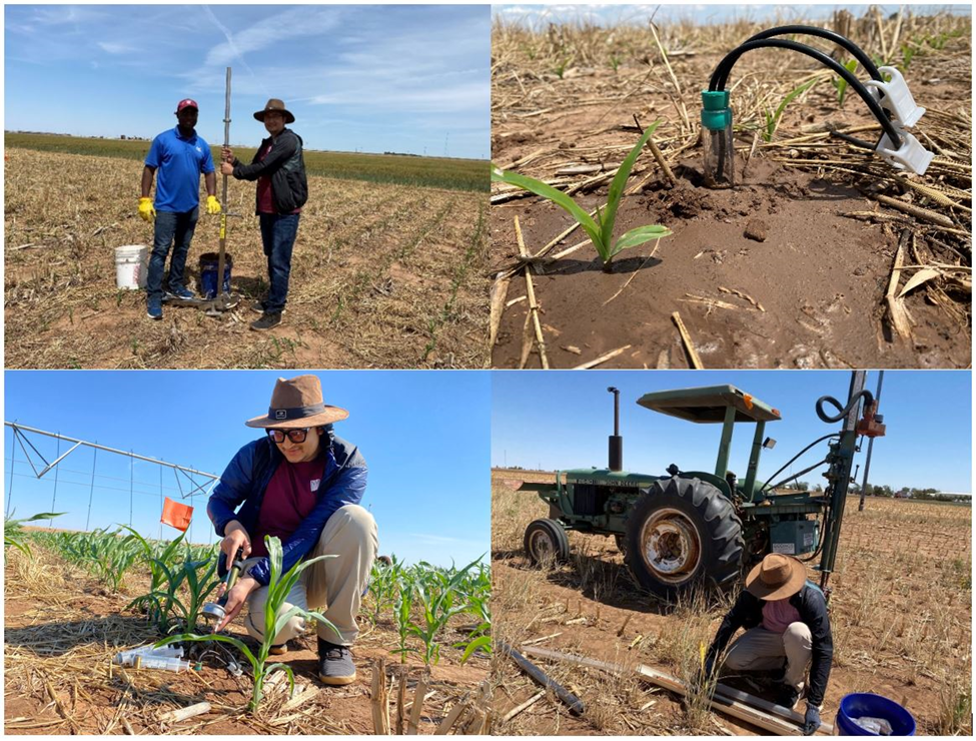
We collected soil samples from each plot at 0–80 cm depth using a tractor-mounted hydraulic probe (Giddings Machine Company Inc., Windsor, CO) after cover crop termination (May 10, 2022) and crop harvest (September 20, 2022). The collected samples were divided into 0–20, 20–40, 40–60, and 60–80 cm depths. The subsample of about 5-g was extracted in 25 ml of 1-M KCl solution and analyzed for inorganic N (NO3-N + NH4-N) using an automated Timberline Ammonia Analyzer (Timberline Instruments, Boulder, CO, USA). Data were analyzed in SAS by using the mixed procedure.
Materials and Methods for Objective 2
Cover crop biomass samples were collected by hand-clipping the aboveground biomass from four randomly thrown 0.25 m2 quadrants in each cover crop plot (Fig. 2). Cover crop canopy coverage at the termination time was estimated by using Canopeo (version 2.0, Oklahoma State University) mobile application. Forage crops (corn and sorghum) samples were collected from a 3.5 m2 area at the time of harvest. The collected cover crop and forage biomass samples were oven-dried at 65ºC for 72 hrs. to estimate the dry weight. The subsamples were ground in a ball mill (Thomas-Wiley laboratory mill, model 4, Arthur H. Thomas Company, Swedesboro, NJ) and sent to Ward Laboratories Inc., Kearney, NE, for forage quality analysis using near-infrared reflectance spectroscopy. Nitrogen uptake by cover crops and forage crops was calculated by dividing the dry matter crude protein by 6.25 (Samarappuli et al., 2014). Data were analyzed in SAS by using the mixed procedure.
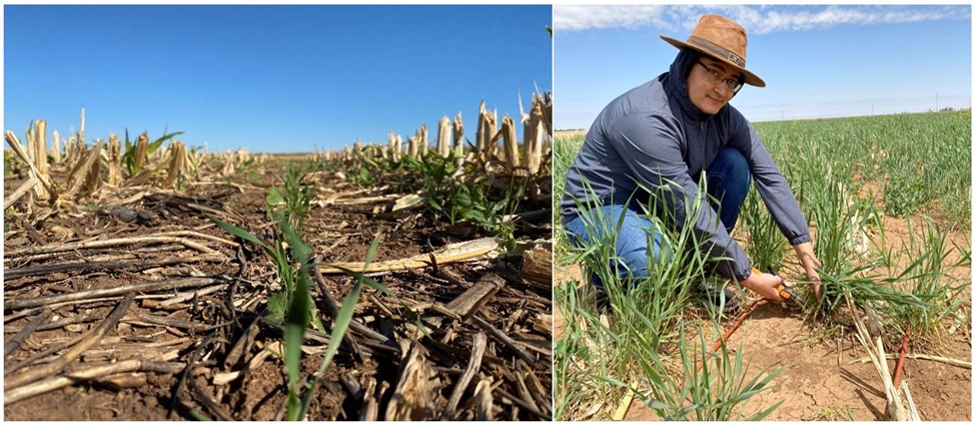
The indices of nutrient use efficiency were expressed as plant N uptake efficiency (PUE), N use efficiency (NUE), and agronomic N use efficiency (ANUE). Plant N uptake efficiency was calculated by using the equation (Eq 1) (Pantoja et al., 2015). Similarly, NUE and ANUE were calculated using equations Eq 2 and Eq 3, respectively (Radicetti et al., 2016).
Cover crops at the termination stage reduced 78–89% of soil inorganic N compared to NCC (NCC, 123–225 kg N ha-1 vs. cover crops, 14–49 kg N ha-1) (Fig. 3A, 3B). With this, the aboveground cover crop biomass could supply 20–38 and 35–37 kg N ha-1 for subsequent sorghum and corn, respectively. After harvesting both of the forage crops, all the treatments had similar inorganic N contents in the soil profile (Fig. 3A, 3B).
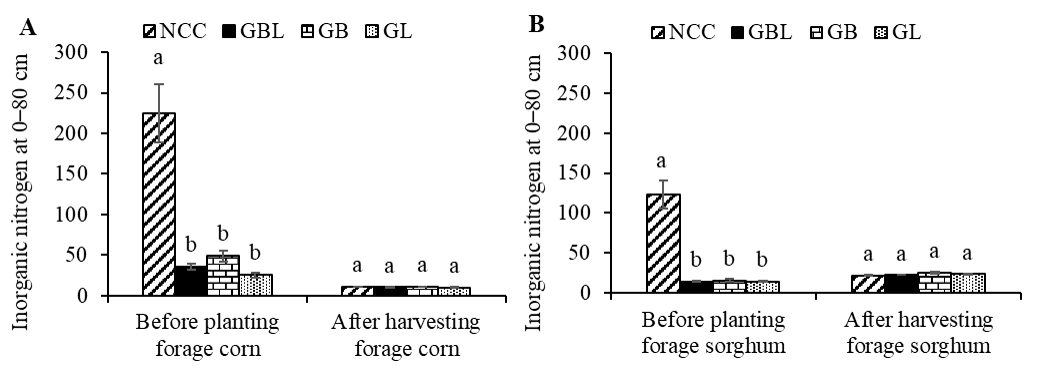
In the cover crop-forage corn rotation, the average cover crop aboveground biomass yield was 1383–1434 kg ha-1, while it was between 754–1325 kg ha-1 in the cover crop-forage sorghum rotation (Fig. 4A, 4B). In both rotations, the proportion of grasses in the mixture was more than 70 %. Similarly, canopy cover ranged from 12 to 20 % and did not differ among treatments in both rotations (Fig. 5). However, forage corn DM yield was 18–23 % greater under cover crops than in NCC, whereas forage sorghum was 20 % greater in GB than under NCC (Fig. 6)
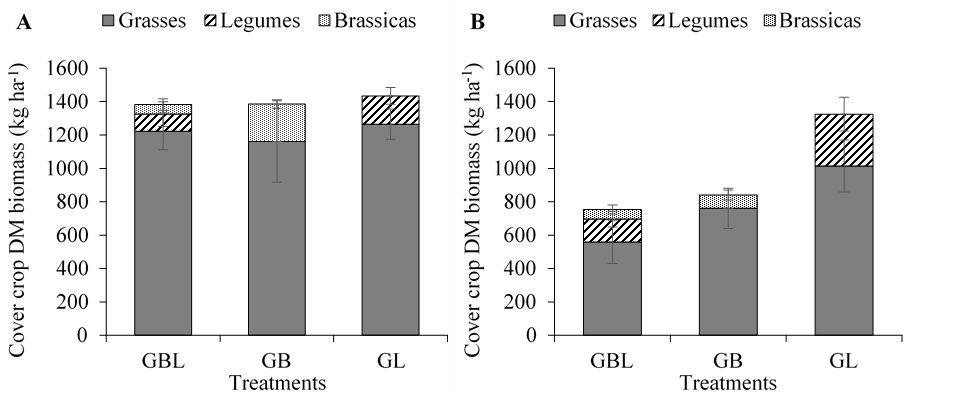
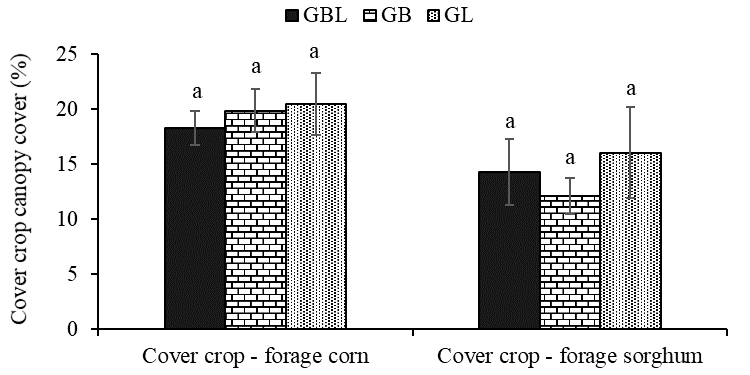
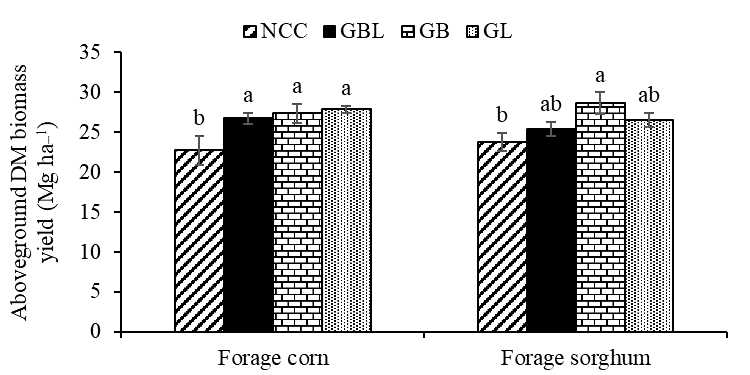
Interestingly, forage corn and sorghum N uptake efficiency was similar for all treatments (Fig. 7). The NUE of cover crop integrated forage corn was positive only for GL when compared with NCC while it was positive for all cover crop mixtures in cover crop integrated forage sorghum systems (Table 1). The ANUE of both forage crops was all positive for all cover crop mixtures (Table 1).

Table 1. Nitrogen use efficiency (NUE) and agronomic nitrogen use efficiency (ANUE) compared to no cover crops control.
|
Treatments |
NUE |
ANUE |
|
|
(%) |
|
|
Cover crop-forage corn |
||
|
GBL |
-0.58±3.76a‡ |
15.5±1.30a |
|
GB |
-4.63±2.12a |
17.8±2.12a |
|
GL |
6.41±3.25a |
19.7±0.87a |
|
Cover crop-forage sorghum |
||
|
GBL |
2.00±3.56a |
6.6±1.78a |
|
GB |
16.31±4.46a |
19.8±2.82a |
|
GL |
3.56±1.82a |
10.7±1.77a |
‡ Mean values (± standard error) followed by different lowercase letters along the column for each variable represent significant differences among treatments (p ≤ 0.05, Fisher’s protected LSD test)
Abbreviations: GBL, grasses + brassicas + legumes; GB, grasses + brassicas; and GL, grasses + legumes
Research Outcomes
- Acharya, P., R. Ghimire, E. Lehnhoff, and M.A. Marsalis. 2022. Cover crop forage potential and subsequent forage sorghum yield and nutritive value. ASA-CSSA-SSSA International Annual Meeting, Baltimore, MD.
- Acharya, P., R. Ghimire, and W.S. Paye. 2022. Soil health changes in cover crop-integrated forage production systems under irrigated semiarid conditions. ASA-CSSA-SSSA International Annual Meeting, Baltimore, MD.
- Acharya P., Ghimire, M.A. Marsalis, E.A. Lehnhoff. 2022. Cover crops for improving forage sorghum yield and nutritive value in water-limited environments. Western Society of Crop Science Meeting, June 21–22, 2022, Fort Collins, CO (link for presentation)
Education and Outreach
Participation Summary:
Outreach Presentations:
- Ghimire, R. Cover crops in a corn rotation: impacts on soil health, water dynamics, and forage quality. 2022 Southwest Hay & Forage Conference, Jan. 26-28, 2022, Ruidoso, NM, #Participants: 125
- Acharya P. and R. Ghimire, Cover crops, soil health and nutrient availability. New Mexico State University Agricultural Science Center at Clovis field day, August 4, 2021, Clovis, NM, #Participant: 83
